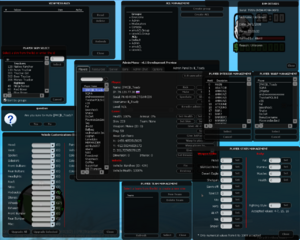Introduction to Scripting the GUI
One important feature in MTA:DM is the ability to script customized GUI (Graphic User Interface). The GUI consists of windows, button, edit boxes, check boxes... Almost every standard form components in graphical environments. They can be displayed while the user is in game, and used for inputs and outpus in place of traditional commands.
A tutorial to make a login window
In this tutorial we'll make a simple login window, with two input boxes and a button. The window appears when the player joins the game, and once the button is clicked, the player is spawned. The tutorial will continue the gamemode we made in Introduction to Scripting. We'll also take a look at client-side scripting.
Draw the window
All the GUI must be made client side. It is also a good practice to keep all the client scripts in a separate folder. Browse to /Your MTA Server/mods/deathmatch/resources/myserver/ directory, and create a folder named "client". Under /client/ directory, create a text file and name it "gui.lua", and in this file we will write a funtion that draws the window:
function CreateLoginWindow() local X = 0.375 local Y = 0.375 local Width = 0.25 local Height = 0.25 wdwLogin = guiCreateWindow(X, Y, Width, Height, "Please Log In", true) end
You may click on the function's name to read its documentation. Note that the coordinates of the window is in percentage of the screen. It means that if the screen is labelled with 0 on the left end, and 1 on the right end, and if "X" is 0.5, it represents the middle of the screen. It applies to Y, window width, and window height as well (if "width" is 0.5, the window will be half as wide as the screen). Next we'll add the text labels (saying "username:" and "password:"), edit boxes and a button. Replace the function with its complete version:
function CreateLoginWindow() local X = 0.375 local Y = 0.375 local Width = 0.25 local Height = 0.25 wdwLogin = guiCreateWindow(X, Y, Width, Height, "Please Log In", true) X = 0.0825 Y = 0.2 Width = 0.25 Height = 0.25 guiCreateLabel(X, Y, Width, Height, "Username", true, wdwLogin) Y = 0.5 guiCreateLabel(X, Y, Width, Height, "Password", true, wdwLogin) X = 0.415 Y = 0.2 Width = 0.5 Height = 0.15 edtUser = guiCreateEdit(X, Y, Width, Height, "", true, wdwLogin) Y = 0.5 edtPass = guiCreateEdit(X, Y, Width, Height, "", true, wdwLogin) guiEditSetMaxLength(edtUser, 50) guiEditSetMaxLength(edtPass, 50) X = 0.415 Y = 0.7 Width = 0.25 Height = 0.2 btnLogin = guiCreateButton(X, Y, Width, Height, "Log In", true, wdwLogin) guiSetVisible(wdwLogin, false) end
Note that every GUI component created is a child of the window, this is done by specifying the parent element (wdwLogin, in this case) when creating the component:
guiCreateLabel(X, Y, Width, Height, "Password", true, wdwLogin)
This is very useful because later when you need to control the entire set of GUI, you can just refer to the parent element. For example:
guiSetVisible(wdwLogin, false) --hides all the GUI we made so we can show them to the player at the appropriate moment.
Using the function we wrote
The CreateLoginWindow function is done, but it won't do anything until we call it. It is recommended to create all GUI when the client resource starts, hide them, and show them to player later when needed. Therefore, we'll write an event handler for "onClientResourceStart" to create the window:
addEventHandler("onClientResourceStart", getResourceRootElement(getThisResource()),
function ()
CreateLoginWindow()
end
)
We would like to show the window when the client joins the game, using the event "onClientPlayerJoin".
function clientPlayerJoin()
outputChatBox("Welcome to My MTA DM Server, please log in. ")
if (wdwLogin ~= nil) then
guiSetVisible(wdwLogin, true)
end
showCursor(true)
guiSetInputEnabled(true)
end
addEventHandler("onClientPlayerJoin", getRootElement(), clientPlayerJoin)
Note that we have a security check before making the window visible, so that in case the window had not been created, in which case wdwLogin is not a valid element, we don't get an error. The showCursor function gives control to your mouse, and guiSetInputEnabled makes sure when you type in the GUI, certain letters like "A", "S", "D", "W", "T" don't move your character or bring out the chatbox input. In the next step, we'll make the button work as desired.
